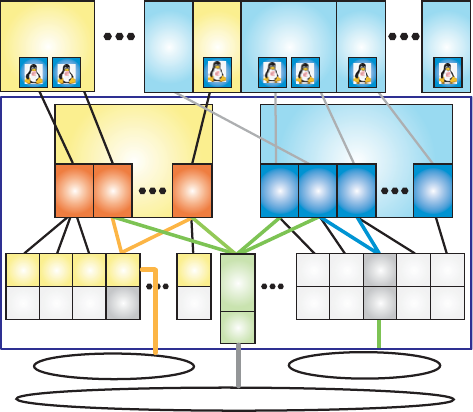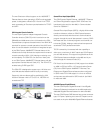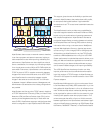
32
HiperSockets does not use an external network, therefore,
it can free up system and network resources, helping to
reduce attachment cost while improving availability and
performance. HiperSockets can have signifi cant value in
server consolidation, for example, by connecting multiple
Linux virtual servers under z/VM to z/OS LPARs within the
same z890. Furthermore, HiperSockets can be utilized by
TCP/IP in place of XCF for sysplex connectivity between
images which exist in the same server, thus z/OS TCP/IP
uses HiperSockets for connectivity between sysplex
images in the same server and uses XCF for connectiv-
ity between
images in different servers. Management and
administration cost reductions over existing confi gurations
are possible.
HiperSockets acts like any other TCP/IP network interface,
so TCP/IP features like IP Security (IPSec) in Virtual Private
Networks (VPN) and Secure Sockets layer (SSL) can be
used to provide heightened security for fl ows within the
same CHPID. HiperSockets supports multiple frame sizes,
which is confi gured on a per HiperSockets CHPID basis.
This support gives the user the fl exibility to optimize and
tune each HiperSockets to the predominant traffi c profi le,
for example to distinguish between “high bandwidth”
workloads such as FTP versus lower bandwidth interactive
workloads.
The HiperSockets function provides many possibilities for
improved integration between workloads in different LPARs,
bound only by the combinations of operating systems and
their respective applications. HiperSockets is intended to
provide the fastest zSeries connection between e-business
and Enterprise Resource Planning (ERP) solutions sharing
information while running on the same server. WebSphere
http and Web Application Servers or Apache http servers
can be running in a Linux image (LPAR or z/VM guest) and
will be able to use HiperSockets for very fast TCP/IP traffi c
transfer to a DB2 database server running in a z/OS LPAR.
System performance is optimized because this allows you to
keep your Web and transaction application environments in
close proximity to your data and helps eliminate any expo-
sure to network related outages, thus improving availability.
The z/OS HiperSockets Accelerator function can help
improve performance and cost effi ciencies when attach-
ing a high number of TCP/IP images via HiperSockets to a
“front end” z/OS system for shared access to a set of OSA-
Express adapters.
HiperSockets VLAN support in a Linux environment: Virtual
Local Area Networks (VLANs), IEEE standard 802.1q, is now
being offered for HiperSockets in a Linux for zSeries environ-
ment. VLANs can help reduce overhead by allowing networks
to be organized for optimum traffi c fl ow; the network is orga-
nized by traffi c patterns rather than physical location. This
enhancement permits traffi c to fl ow on a VLAN connection
between applications over HiperSockets and between appli-
cations on HiperSockets connecting to an OSA-Express Giga-
bit Ethernet, 1000BASE-T Ethernet, or Fast Ethernet feature.
LCSS0 LCSS1
LPAR
15
LPAR
14
LPAR
18
MIF-1 MIF-2 MIF-F MIF-1 MIF-2 MIF-3 MIF-F
CHPID
00
CHPID
02
CHPID
01
CHPID
FF
PCHID
010B
PCHID
010D
PCHID
010C
PCHID
020A
CHPID
04
SPAN
CHPID
00
CHPID
05
Share
CHPID
01
PCHID
0245
PCHID
0246
CHPID
22
PCHID
0248
CHPID
FF
PCHID
0249
CHPID
03
Share
Linux
HiperSockets CHPID 04
z/VM
LPAR
17
z/OS
HiperSockets CHPID 05
HiperSockets CHPID 03
LPAR
30
LinuxLinux
z/VM
LPAR 1


















